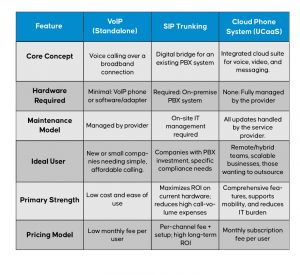Cutting Through the Jargon
Choosing a business phone system means navigating a sea of confusing acronyms: VoIP, SIP, UCaaS. This technical jargon can be a barrier for leaders who need to make a strategic decision that impacts everything from operational efficiency to customer experience. This guide cuts through the complexity to clarify what these technologies are and which one best fits your company's size, workflow, and goals.
VoIP:The Foundation
Voice over Internet Protocol (VoIP) is the technology that lets you make phone calls over an internet connection instead of traditional phone lines. It works by converting your voice into digital data that travels over your broadband connection. All you need is a stable internet connection and a compatible device, like a computer with a headset, a special VoIP phone, or a traditional phone with an adapter.
- Who It's For: Startups, small businesses, and home-based offices that need a professional, budget-friendly, and simple phone service.
- Key Benefits: The primary advantages are significant cost savings on calls (especially long-distance) and scalability, as it's easy to add or remove users. It also inherently supports remote work.
- Potential Drawbacks: It depends entirely on a reliable internet connection; a power or internet outage can disrupt service. Basic VoIP plans may also lack the advanced call management features larger businesses need.
SIP Trunking:The Upgrade
Session Initiation Protocol (SIP) Trunking is a service that connects your existing on-premise Private Branch Exchange (PBX) phone system to the internet. It replaces traditional, physical phone lines with a virtual connection, allowing a business that has already invested in PBX hardware to get the cost-saving benefits of internet telephony.
- Who It's For: Established businesses with a significant investment in an on-premise PBX system they aren't ready to replace. It's also ideal for multi-location enterprises or industries with strict security requirements that need to keep hardware on-site.
- Key Benefits: Major cost savings for businesses with high call volumes, and it allows you to preserve your investment in existing hardware. It also improves reliability with features like automatic call rerouting during an outage.
- Potential Drawbacks: It requires you to own and maintain an on-premise PBX, which can be complex and requires IT expertise.
UCaaS :The All-in-One Solution
Unified Communications as a Service (UCaaS) is a complete, cloud-hosted platform that bundles all your communication tools—voice, video conferencing, team chat, and file sharing—into a single, seamless application. A third-party provider manages all the technology, so you simply pay a subscription fee to access the services over the internet.
- Who It's For: Businesses with hybrid or fully remote teams, fast-growing companies that need to scale instantly, and any organization wanting to reduce its IT workload.
- Key Benefits: Ultimate flexibility and mobility for your workforce, with no hardware to purchase or maintain. It provides a rich suite of advanced features, including integrations with other business software like CRMs.
- Potential Drawbacks: Like VoIP, it is completely dependent on a high-quality internet connection. The per-user subscription fee is a recurring operational expense that grows with your team.
The Decision Desk

Key Questions to Ask
- Do you have an existing PBX system? If yes, and you want to keep it, SIP Trunking is the logical upgrade.
- What is your primary goal? If it's simply to get the lowest cost for basic phone calls, standalone VoIP is your answer.
- How does your team work? If you have a remote or hybrid workforce, UCaaS provides the necessary tools for seamless collaboration.
- How much IT involvement do you want? If the goal is to outsource maintenance and management, UCaaS is the clear choice.
Conclusion: Making Your Choice
The right communication system depends entirely on your business's specific needs, budget, and existing infrastructure.
- VoIP offers simplicity and low-cost entry.
- SIP Trunking leverages and modernizes existing assets.
- UCaaS provides an all-in-one, future-ready solution for modern, flexible teams.
As work continues to evolve with trends like AI and hybrid models, a unified platform is often the most adaptable choice for the future. However, a clear understanding of your current requirements is the most critical factor in making a decision that will support your business today and power its growth tomorrow.





